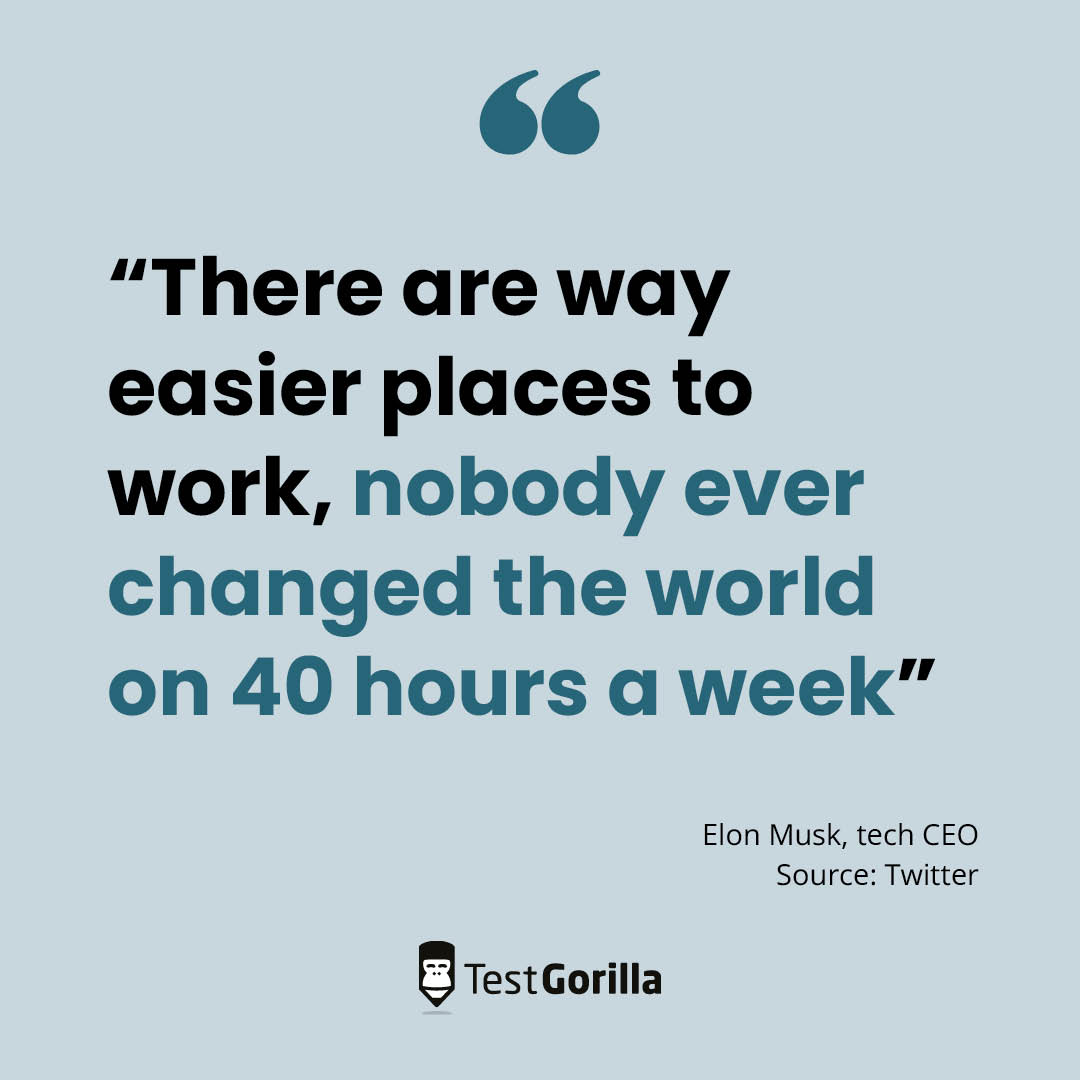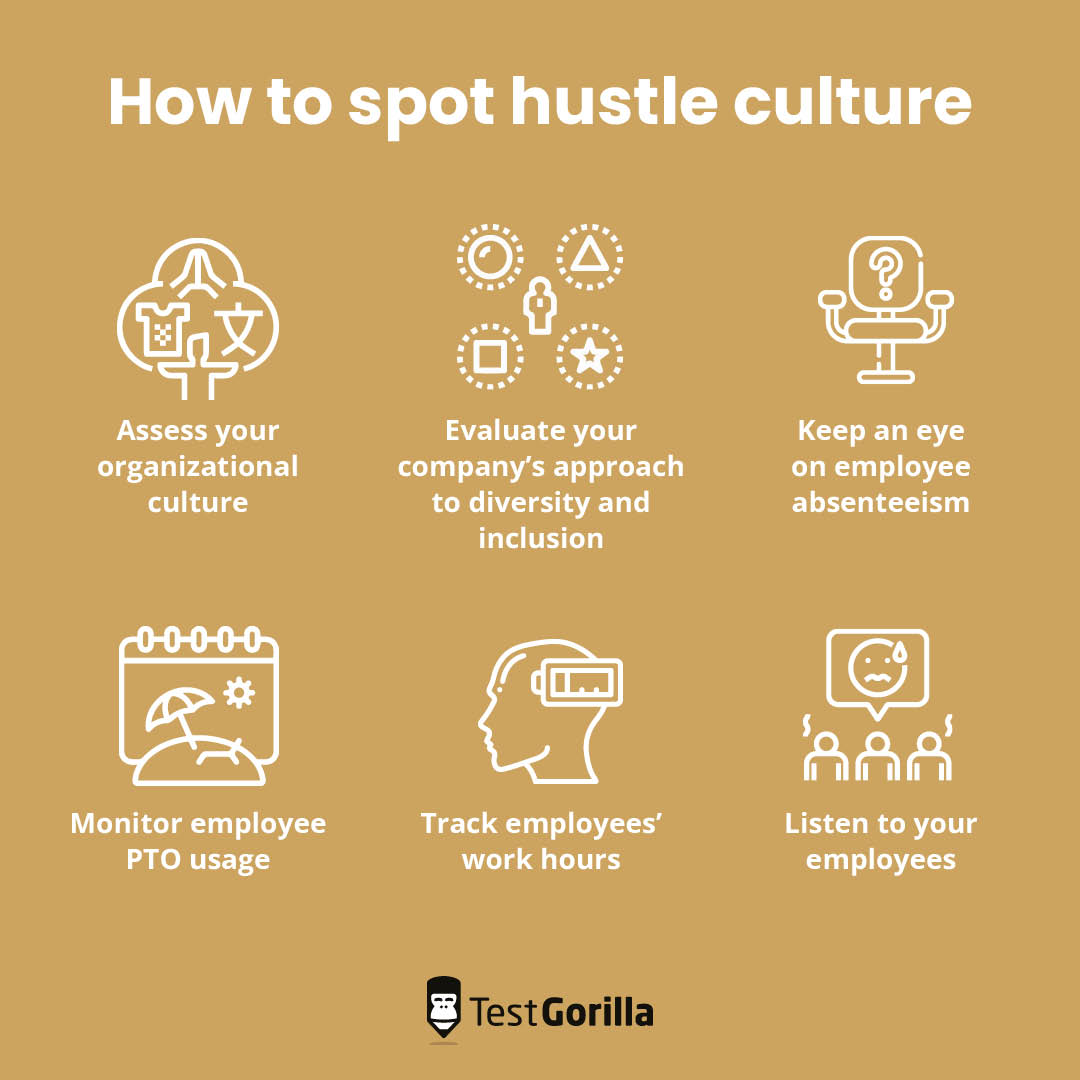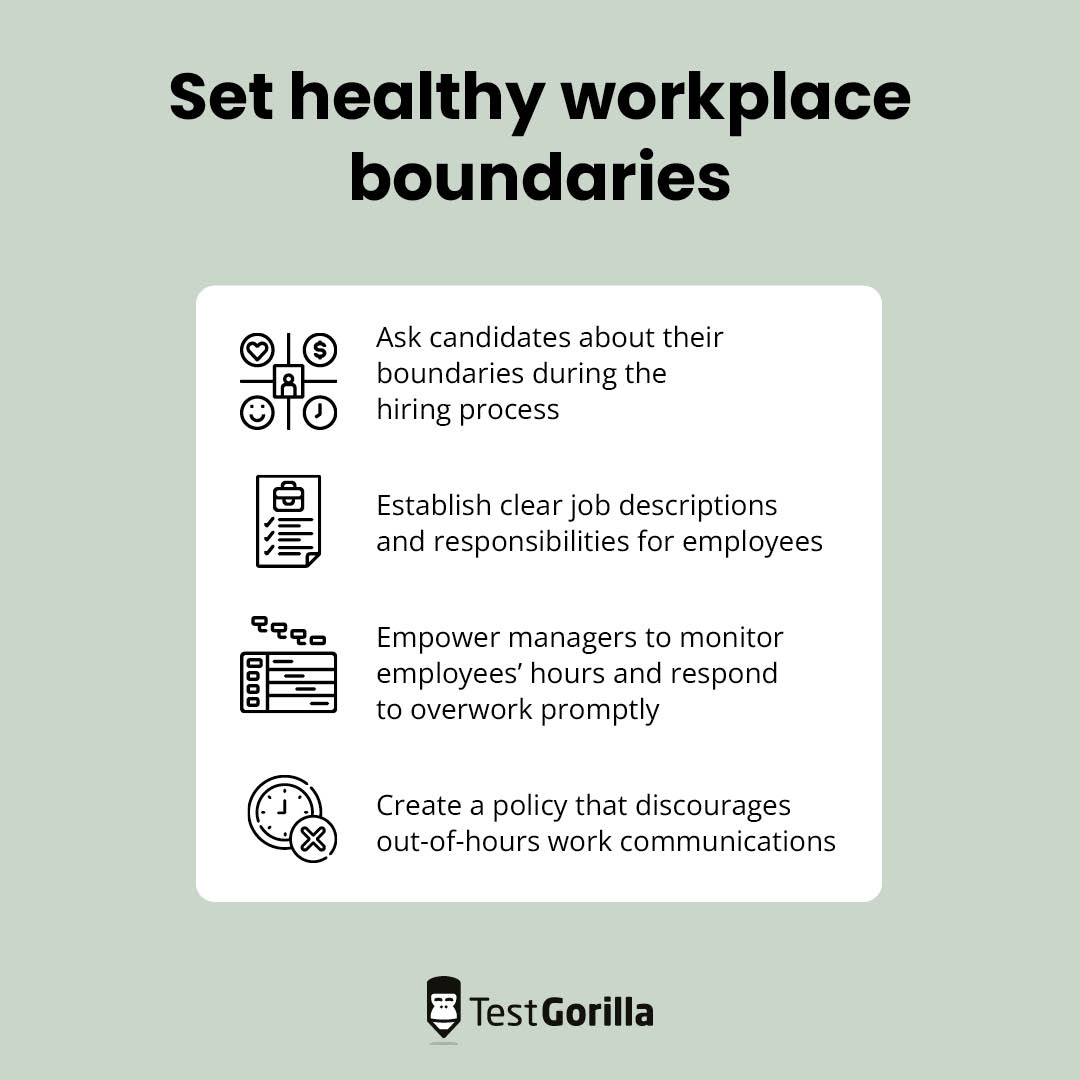As an HR leader, you care about staff wellbeing.
But your employees have stopped taking breaks. Worse – they’ve stopped going home on time, and are usually at their desks before you in the mornings.
They insist they’re happy to be there. They even compete with each other, bragging about how late they stay and how early they arrive. But you can’t help noticing how tired they look – and their work doesn’t seem to be improving.
More recent hires tell you they feel pressured to work as hard and fast as their colleagues. Just last week, one of them went on medical leave with burnout.
Do you think these employees are working productively?
This is hustle culture in action. And while it can lead to short-term productivity boosts, its long-term consequences are devastating.
This article explores what hustle culture is, how to spot it, and how to build a better culture within your company.
Table of contents
- What is hustle culture?
- What are the effects of a hustle culture on workers?
- What are the effects of a hustle culture on companies?
- So then, why is hustle culture so popular?
- How to spot hustle culture: The signs and symptoms
- The alternative to hustle culture: An inclusive culture that focuses on outcomes over inputs and values employee health
- 9 tips for implementing a healthy, productive, inclusive workplace culture
- Eradicate hustle culture by hiring for culture add
- Sources
What is hustle culture?
Hustle culture is the idea that you can achieve anything if you focus on work above everything else. It asks workers to deprioritize their personal lives and mental wellbeing by working long hours and giving work their full attention.
It’s a manifestation of the American dream – the idea that if you work hard, you will earn success and happiness. Needless to say, that isn’t always the case, especially for people of color and others who experience discrimination and oppression.
Closely linked with workaholism, hustle culture encourages a “rise and grind” mindset of toxic productivity. It leaves employees overworking at the expense of their own health and wellbeing, usually leading to burnout.
Hustle culture examples
What does hustle culture look like in practice? If any of these examples speak to your experience at work, your company may have a cultural problem.
Employee | Hustle culture behavior | The reason behind it |
Ifeyinwa, a 27-year-old marketing manager | Staying late and showing up early every workday | Employees are rewarded, directly or indirectly, for being present and enthusiastic at all times within a hustle culture |
Haru, a 41-year-old sales representative | Sending and responding to work emails out of hours | Even when not at their desks, employees in a hustle culture feel pressured to work |
Kay, a 25-year-old content writer | Rushing through tasks at the expense of quality work | Hustle culture leads workers to focus on how much they do over how well they do it |
Jose, a 55-year-old accountant | Refusing to use PTO days even though his company offers unlimited PTO | The toxic productivity mindset encouraged by hustle culture treats breaks as laziness, which leaves employees feeling unable to take time off |
Marlowe, a 29-year-old programmer | Missing sleep and meals because of work, and bragging about it to coworkers | Hustle culture encourages employees to compete with each other to work hardest, even to an unhealthy extent |
What are the effects of a hustle culture on workers?
In the short term, hustle culture encourages workers to give their best, increasing productivity and performance. But this is rarely true for long because prolonged hustling behavior causes elevated stress, leading to burnout.
A 2022 Deloitte survey found that one in three workers struggles with fatigue and poor mental health. It also found that:
83% of employees face obstacles in trying to achieve wellbeing goals
30% of employees cited a heavy workload or stressful job as an obstacle to better wellbeing
27% of employees don’t have time to work on their wellbeing because they work too many hours
A toxic hustle culture undermines employees, even in free time outside of the workplace. Here are the biggest impacts that hustle culture has on workers.
The consequence | How it impacts workers |
Mental health impacts | The competitive mentality of hustle culture leads to anxiety, stress, and depression |
Physical health impacts | Elevated levels of stress increase workers’ risk of fatigue, digestive problems, high blood pressure, and heart attacks[1] |
Toxic competitive mindset | When employees feel in competition with coworkers, , which limits collaboration and harms |
Poor work-life balance | Employees struggling with poor work-life balance experience elevated stress and strained relationships at home and work |
Employee burnout | Burnt-out employees , unhappy, and ultimately unproductive at work |
What are the effects of a hustle culture on companies?
Hustle culture may boost productivity and profits in the short term. But is the tradeoff worth it?
The negative effects of hustle culture for workers lead to direct consequences for business owners.
Here are the worst effects of hustle culture on companies, along with how they hurt your workplace.
The consequence | How it impacts your company |
A toxic culture is a factor than compensation when determining a company’s attrition rate – employees in a toxic workplace are more likely to quit, | |
Challenges when recruiting | More than want flexible working arrangements, and if your company refuses to offer that, it risks alienating top talent |
Employee absenteeism | When exhausted employees fall into a pattern of absenteeism, it hurts a company’s productivity, bottom line, and |
Employee presenteeism | Putting pressure on employees to show up when sick makes them more prone to making mistakes and producing lower-quality work, in addition to risking other workers’ health |
Employee burnout | Burnout is a major factor increasing employee turnover, with prepared to leave their job for companies with better support for burnt-out workers |
So then, why is hustle culture so popular?
Despite all these downsides, hustle culture is deeply entrenched in most modern countries. And believe it or not, there are good reasons for that.
Part of the appeal of hustle culture is that its advocates recognize that talent is secondary. Anyone can hustle, regardless of their innate gifts. Hustle culture promises that anyone can achieve success if they’re willing to put in the hours – even those without the talent or competence to succeed on merit. It’s an appealing idea for many workers.
Anyone wanting to get ahead professionally must work hard to do it.
That kernel of truth at the heart of hustle culture is hard for anyone to deny.
But hustle culture has been pushed to extremes by social media influencers and public figures in business. It boasts a list of big-name “hustlers,” including:
Gary Vaynerchuk, entrepreneur and influencer, who claimed to be “blown away” by the idea that anyone would want to celebrate the end of the work week[2]
Jeff Bezos, whose core principles at Amazon involve hiring people who will never say “that’s not my job”
Elon Musk, tech CEO, who famously claimed that “nobody ever changed the world on 40 hours a week”[3]
It broke into the mainstream during the early days of Silicon Valley’s start-up culture, which demanded hard work but promised professional and financial success.
From there, it’s been co-opted as a lifestyle by influencers on social media platforms like TikTok, who use their own entrepreneurial success as proof that hustling works – and that it can work for their followers, too.
And as influencers compete for views, likes, and subscriptions, they encourage increasingly extreme behaviors in the name of the grind. Hustle culture has become a marketing tool, despite its unhealthy consequences for workers and companies.
How to spot hustle culture: The signs and symptoms
The consequences of hustle culture can be damaging. And even if you believe your company fosters a healthy culture, your employees might still have their own motivations that keep them in a hustling mentality.
HR professionals need to be vigilant about the signs of hustle culture, so you can address it and limit its impact.
Here’s a step-by-step guide to help you spot the most common warning signs.
Assess your organizational culture. In particular, determine whether your company has a competitive or collaborative culture. While a competitive culture isn’t a sign of a toxic hustle culture in its own right, it can be a warning sign.
Evaluate your company’s approach to diversity and inclusion. If your company struggles to retain employees of color, female employees, or employees from other marginalized groups, it may point to a larger cultural issue.
Keep an eye on employee absenteeism. A pattern of unplanned absences is an early warning sign for possible employee burnout. Tracking absenteeism across entire teams is a useful way to monitor problems that drive staff absence.
Monitor employee PTO usage. If your employees aren’t using their allotted PTO, it may indicate that they feel pressured to avoid taking time off.
Track employees’ work hours. Are your staff consistently showing up early and staying late? If so, it may be a consequence of hustle culture, which puts pressure on workers to go above and beyond at all times.
Listen to your employees. They have a ground-level perspective of your company’s culture. As long as you provide them with anonymity, they offer valuable insights into the day-to-day realities of your business.
The alternative to hustle culture: An inclusive culture that focuses on outcomes over inputs and values employee health
Hustle culture is toxic. It prioritizes output over employee wellbeing at the expense of healthy workplace culture. In the long term, the stress and fear resulting from hustle culture undermine your employees’ ability to do their best work.
And while there is truth to its messaging about the importance of hard work and dedication, that message has been warped beyond recognition into a system of beliefs that damages workers’ health, companies’ cultures, and everyone’s work-life balance.
So what’s the alternative?
You must build an inclusive company culture focusing on long-term success, not short-term outcomes.
Past a certain point, employee output from hustling doesn’t accomplish anything. Nobody can sustain peak productivity at every minute of every day. It’s better to focus on working efficiently in a way that still delivers results.
Employees are capable of doing great work without grinding 24 hours a day, seven days a week. If you support your employees to do that work in a way that works for them, you’ll see great results – and a reduction in burnout.
Supporting your employees in delivering top-tier outcomes means offering them:
Flexibility in work location and hours, where possible
Opportunities to train and develop their skills
Support for their health and wellbeing
If you’re prepared to build this kind of culture, diversity and inclusion will come more naturally to your workplace. A culture focused on the long term enables neurodiverse employees to work in ways that suit their needs, and empowers workers with children to balance their work with family commitments.
As a result, your company is rewarded with higher morale and engagement – which is linked to improvements in productivity and profitability. It’s a recipe for success for everyone.
9 tips for implementing a healthy, productive, inclusive workplace culture
Now that you know what you’re aiming for, how can you take your company there?
Follow these nine top tips to build a healthier, more inclusive culture at your company without sacrificing productivity or profit.
Healthy workplace culture at a glance
The strategy | How it works |
Help workers prioritize | Create a culture of working efficiently and smartly to meet reasonable performance goals |
Hire staff with time management skills | Build a workforce of employees with the necessary skills to work in an efficient, self-directed way |
Empower employees to develop their skills | Encourage a culture of development and collaboration over competition and fear |
Set healthy workplace boundaries | Endorse a healthy attitude to work-life balance from the top down, empowering workers to strike a better balance |
Encourage workers to take breaks | Advocate for self-care, destigmatize downtime and promote a healthier work-life balance within your company |
Train managers to recognize burnout | Ensure that your company catches cases of burnout early, so you can address them before they become too serious |
Offer wellness and health initiatives | Build a workplace culture that puts people first and respects the importance of health and wellbeing |
Build a psychologically safe workplace | Bolster employee morale by ensuring that all employees feel safe and welcome at work |
Stamp out toxic workplace behaviors | Reduce employee burnout and turnover by tackling the most toxic manifestations of hustle culture |
1. Help workers prioritize
Hustle culture has a lot to say about working harder, but the key to maximizing productivity is working smarter. When you empower your workers to do that, they deliver higher-quality work promptly and efficiently.
There are plenty of approaches to prioritizing tasks, including:
“Eat the Frog” – finishing the most complex tasks first
The Eisenhower Matrix – a framework to help you determine and compare task importance
The ABCDE method – grading your tasks to help prioritize and even trim your task list
Chunking – batching tasks to be completed together, uninterrupted, and work more efficiently
Choose any of the above prioritization methods for your organization and its workflow and implement it across your company.
Establishing a clear process for prioritizing tasks is a decision that impacts your company culture. It creates the expectation that staff should work efficiently and intelligently instead of throwing themselves into hard but ineffective work for its own sake.
Combine this approach with a performance management process emphasizing realistic, attainable goals. Then back it up with a system of rewards and incentives, and watch your employees learn the value of prioritizing tasks.
2. Hire staff with time management skills
Prioritizing work effectively depends on good time management. But how can you hire employees with the necessary skills to plan their time effectively?
TestGorilla’s Time Management test enables managers to screen potential hires for time management skills. If you hire people who already have the skills you’re looking for, they’ll be ready to apply those skills on their first day.
But the work doesn’t stop there. Without further training, employees are likely to stagnate and stop delivering their best work. You need to keep offering your staff opportunities to develop the soft skills, like time management, that keep them productive.
Hiring trainable candidates, who have the cognitive ability to learn and apply new skills, makes ongoing training simple. By staffing your company with people who are quick, enthusiastic learners, you stand yourself in great stead to continue developing as a company.
3. Empower employees to develop their skills
Committing to a culture of ongoing training and development makes your company irresistible to top talent.[4]
Employees want opportunities to hone their skills at work – and it’s in your interest as an employer to facilitate that.
Offer your employees the time and budget they need to develop their skills. Don’t limit them to a rigid career path – a career portfolio approach gives your employees room to learn more widely and build a broader range of skills.
It also places less pressure on employees to conform to an inflexible model of linear success. Hustle culture stresses the importance of focusing solely on pursuits that bring you success.
Giving your employees scope for self-directed learning allows them to discover what success means to them.
Building a culture of ongoing learning is an important part of becoming a skills-based organization, with all the benefits of inclusivity and diversity that a skills-based approach entails.
4. Set healthy workplace boundaries
Hustle culture never sleeps, never stops, and definitely never lets a Slack message go unanswered. This grindset leads to unhealthily long hours, a toxic and competitive work environment, and, ultimately, burnout.
Get ahead of the problem by setting healthy workplace boundaries. Establishing clear expectations of your employees prevents a hustle mindset from escalating unchecked in your workplace.
Good boundaries aren’t just about work-life balance. They also address employees’ roles and responsibilities, especially in relation to each other. Here are some steps you can take to build a culture that respects employees’ limitations:
Ask candidates about their boundaries during the hiring process
Establish clear job descriptions and responsibilities for employees
Empower managers to monitor employees’ hours spent at work, and respond to overwork promptly
Create a policy that discourages out-of-hours work communications
5. Encourage workers to take breaks
When employees take regular breaks, it fosters a healthier work-life balance, leading to reduced stress and a lower risk of burnout.
And employees know it: 78% of workers support a policy of mandatory PTO.[5]
The same study found that employees with access to an unlimited PTO policy reported the best work-life balance.
Bear in mind that unlimited PTO only works within a culture that enables employees to use it responsibly. Employees shouldn’t feel pressured not to use PTO, and you should implement clear guidelines that ensure sensible and fair use.
PTO isn’t the only type of break you can encourage. Consider a policy that encourages employees to take lunch breaks away from their desks, or to take regular micro-breaks.[6]
These short breaks in the workday leave employees feeling refreshed and ready to tackle new challenges when they get back to their desks.
6. Train managers to recognize burnout
Burnout is devastating for employees and employers alike. It leaves workers feeling exhausted, and creates a problem of absenteeism and lost productivity for employers.
Fortunately, it’s possible to recognize burnout early. Here are some strategies to identify burnout before it becomes a wider problem:
Send out regular pulse surveys to assess employee engagement and satisfaction
Monitor employees’ absences from work for unexpected spikes
Use regular 1:1 meetings to stay in touch with your employees’ moods
Train your managers to recognize the most common signs of burnout. As they have direct contact with their employees, they are best placed to identify any problems early.
You should also set up a company policy that outlines your approach to dealing with burnout. Providing support through employee assistance programs, flexible working arrangements, and coaching makes all the difference to struggling employees.
7. Offer wellness and health initiatives
When establishing your burnout response policy, consider the wellness and health initiatives your company offers. They’re a great way to improve your employees’ overall mental and physical wellbeing, and help to avoid or mitigate health problems in the future too.
These initiatives may involve offering non-traditional benefits, such as:
Half-day Fridays during summer months
Access to mindfulness and meditation apps
Financial planning advice and support
Gym memberships
Healthy snacks in the workplace
Consider combining these non-traditional perks with more standard provisions, including mental health support and comprehensive medical insurance.
This approach helps to counteract hustle culture by putting people first. Hustle culture burns employees out because it treats them as sources of profit instead of human beings.
Address that mentality in your workplace by showing employees you care about their wellbeing.
8. Build a psychologically safe workplace
A psychologically safe workplace is one where employees feel safe to speak up, ask questions, share ideas, and make mistakes.
It’s the opposite of the type of environment fostered by hustle culture, in which mistakes are anathema and employees are expected to “tough out” any challenges.
It’s based on mutual trust and strong relationships at work. When employees trust each other (and their managers), they feel more confident and less afraid to express themselves or slip up.
To build a psychologically safe environment, start at the highest level. Establish company values that reflect a commitment to psychological safety, and train your managers to lead by example.
Then start hiring new people based on culture add to build a workforce that lives out your values every day.
Psychological safety at work also leads to a more inclusive, diverse workplace. Employees from all walks of life feel empowered to do their best work in this kind of environment.
9. Stamp out toxic workplace behaviors
Hustle culture breeds toxic behaviors. If you want to commit to psychological safety, you need to eradicate toxic behaviors from your workplace.
No company can afford to excuse bad behavior, even from an otherwise brilliant employee. A workplace with a hustle culture might tolerate casual insults, putdowns, dismissals, and shaming from a high performer within the company – but it’s terrible for employee morale and your company’s reputation.
Left unchecked, it may even escalate into workplace bullying.
Every time you excuse toxic behavior, you signal to all your other employees that it’s acceptable. Over time, one person’s abusive actions in the workplace can spiral into a culture that leaves other employees feeling pressured into participating in hustle culture, too.
Take bad behavior seriously, and empower your managers to address it with disciplinary action. Otherwise, you put your company culture at direct risk.
Eradicate hustle culture by hiring for culture add
Hustle culture is toxic for employers and employees. Don’t be fooled by its promise of a bump in efficiency for your business. It leads to health issues, disengagement, and burnout among employees, hurting your company’s productivity and bottom line.
As an HR leader, it’s on you to tackle hustle culture by building a culture that trusts its employees to work in the ways that suit them best.
By empowering your staff to prioritize tasks, look after their health and wellbeing, and work in psychologically safe conditions, you limit the worst impacts of hustle culture without losing out on productivity or profit.
Take the first step toward eradicating hustle culture by hiring for culture add. Use TestGorilla’s personality tests to find candidates who will contribute to your company’s culture and embody your values.
Sources
“Beware High Levels of Cortisol, the Stress Hormone”. (August 23, 2022). Premier Health. Retrieved May 31, 2023. https://www.premierhealth.com/your-health/articles/women-wisdom-wellness-/beware-high-levels-of-cortisol-the-stress-hormone
Vaynerchuk, Gary. (July 3, 2017). “I F*cking Hate Friday”. Gary Vaynerchuk. Retrieved May 3, 2023.https://garyvaynerchuk.com/fucking-hate-friday/
Musk, Elon. [@elonmusk]. “There are way easier places to work, but nobody ever changed the world on 40 hours a week”. Twitter, November 26, 2018. https://twitter.com/elonmusk/status/1067173497909141504
Abdou, Anouare (January 19, 2023). “Job Satisfaction Looks Different in 2023 – Here’s Why”. Hive. Retrieved May 31, 2023. https://hive.com/blog/job-satisfaction/
“How Do Unlimited Vacation Policies Affect Employees? Over 1,000 Employees Weigh In”. (March 24, 2022). Joblist. Retrieved May 31, 2023. https://www.joblist.com/trends/are-unlimited-vacation-policies-a-luxury-or-a-lie-over-1-000-employees-weigh-in
6. Albulescu, Patricia, et al. (August 31, 2022). “”Give me a break!” A systematic review and meta-analysis on the efficacy of micro-breaks for increasing well-being and performance”. PLOS ONE. Retrieved May 31, 2023. https://journals.plos.org/plosone/article?id=10.1371/journal.pone.0272460
Related posts
Hire the best candidates with TestGorilla
Create pre-employment assessments in minutes to screen candidates, save time, and hire the best talent.
Latest posts
The best advice in pre-employment testing, in your inbox.
No spam. Unsubscribe at any time.

Hire the best. No bias. No stress.
Our screening tests identify the best candidates and make your hiring decisions faster, easier, and bias-free.
Free resources
This checklist covers key features you should look for when choosing a skills testing platform
This resource will help you develop an onboarding checklist for new hires.
How to assess your candidates' attention to detail.
Learn how to get human resources certified through HRCI or SHRM.
Learn how you can improve the level of talent at your company.
Learn how CapitalT reduced hiring bias with online skills assessments.
Learn how to make the resume process more efficient and more effective.
Improve your hiring strategy with these 7 critical recruitment metrics.
Learn how Sukhi decreased time spent reviewing resumes by 83%!
Hire more efficiently with these hacks that 99% of recruiters aren't using.
Make a business case for diversity and inclusion initiatives with this data.




















